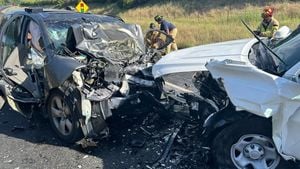NASA astronauts are currently facing an uncertain future as their planned eight-day mission aboard the International Space Station (ISS) has unexpectedly extended beyond two months. This surprising delay is primarily due to unresolved technical issues with Boeing's Starliner spacecraft, which complicates the astronauts' return home.
The mission launched on June 5, 2024, marked the first crewed flight of the Starliner, aimed at demonstrating its reliability for transporting astronauts to and from the ISS. Initially, NASA was hopeful this mission would lessen its reliance on the Russian Soyuz spacecraft.
Unfortunately, the optimism surrounding the Starliner quickly dimmed as technical glitches emerged, surfacing concerns about its safety and reliability. The spacecraft has faced key propulsion system failures, helium leaks, and thruster malfunctions, prompting NASA to contemplate alternative solutions for the astronauts' safe return.
If Boeing doesn't rectify these technical issues soon, astronauts Butch Wilmore and Sunita Williams might be stranded until as late as February next year. NASA officials hinted at turning to SpaceX's Crew Dragon for help, emphasizing the seriousness of the Starliner situation.
The Starliner's issues became evident shortly after Wilmore and Williams docked at the ISS. During the docking maneuver, four out of 28 thrusters malfunctioned, raising alarms about the spacecraft's reliability for future missions.
Boeing, on their part, remains optimistic about the Starliner's prospects. They have publicly stated, "Boeing remains confident in the Starliner spacecraft and its ability to return safely with crew."
This confidence, at this point, faces skepticism from industry analysts and experts.
Adding to the complications, NASA recently postponed its Crew-9 mission aboard SpaceX, which was supposed to lift off mid-August. This delay provides mission planners with time to devise alternatives for the prolonged stay of Wilmore and Williams, as current docking ports are filled with other missions.
SpaceX, recognized for its reliability through the Crew Dragon program, is now being reconsidered to facilitate the astronauts' return. A potential scenario might involve utilizing the Crew-9 mission for their safe trip back to Earth, but urgency remains as NASA officials need to finalize these arrangements soon.
NASA continues to prioritize the astronauts' safety. Steve Stich, manager of NASA's Commercial Crew Program, commented, "Our prime option is to return Butch and Suni on Starliner," noting they had backup plans should it be necessary.
Even though NASA keeps Starliner as their primary plan, preparations for the Crew-9 mission are actively underway. Typically, Crew-9 is set to carry four astronauts, but it may end up transporting just Wilmore and Williams, depending on the situation.
This predicament is not Boeing's only struggle. The company has faced intensified scrutiny over recent years related to its overall safety record and previous troubles with commercial jetliners, creating extra pressure to resolve the Starliner issues quickly.
To combat the technical setbacks, NASA has mobilized additional expert teams to identify the underlying problems with Starliner. The concerns extend beyond the immediate astronaut return, touching on the future of commercial space travel and the partnership with Boeing.
Despite the unexpected extension of their mission, both Wilmore and Williams maintain positive attitudes. Wilmore pointed out, "I have a real good feeling in my heart. The spacecraft will bring us home with no problem."
Their resilience amid challenges illustrates the adventurous spirit inherent to their roles as astronauts.
The current scenario highlights the need for reliable space travel systems, as human exploration ventures beyond Earth continue. Effectively addressing these challenges will be critical for the upcoming missions NASA has lined up.
Future discussions will focus on how NASA and its commercial partners can collaborate more efficiently. The next few weeks will be pivotal—will Boeing's Starliner restore its credibility, or will SpaceX's Crew Dragon become NASA's primary fallback option for astronaut transportation?
Each passing day builds tension, with the space community closely monitoring the situation. The interplay between ensuring crew safety and achieving successful missions encapsulates the evolving nature of human spaceflight pursuits.
These high-stakes developments reflect not only the current challenges faced by NASA and Boeing but also the future hurdles looming for commercial space travel. Every incident could significantly influence astronaut safety and the resilience of missions for years to come.



